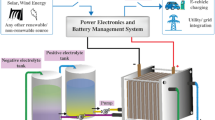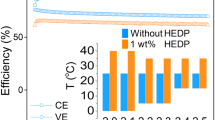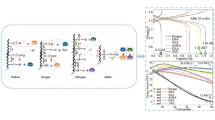Abstract
Redox flow battery technology has received much attention as a unique approach for possible use in grid-scale energy storage. The all-vanadium redox flow battery is currently one of the most advanced battery systems because of the symmetric design of its positive and negative electrolyte solution. However, the thermal and chemical instabilities of V(V) species as well as the permeation problem have caused incompatibility issues among the flow battery system, especially the membrane separator and electrode. It is essential to understand the underlying fundamentals of vanadium stability in order to provide guidelines for the development of advanced composite membrane and electrode and eventually address the incompatibility issue. In this study, we illustrate the kinetics parameters of V(V) crystallization via an in situ Raman study. Our results show that a 1.5-M V(V) solution with 2.625-M H2SO4 has a three times higher rate constant of crystallization and lower effective activation energy (44.67 kJ·mol−1) than a 2-M V(V) solution with 3.5-M H2SO4 (52.10 kJ·mol−1) during heat treatment at 60 °C, 65 °C, and 70 °C. In addition, the 2-M V(V) solution with 2.125-M H2SO4 had a much higher rate constant and much lower effective activation energy (25.13 kJ·mol−1) than the previously described two solutions, which indicates the paramount effect of the H2SO4 concentration on V(V) crystallization. We attribute the improved stability of the 2-M V(V) solution with 3.5 M H2SO4 to the formation of V–O-V-H2SO4 complexes under the high H2SO4 concentration.
Graphical Abstract






Similar content being viewed by others
References
Beaudin M, Zareipour H, Schellenberglabe A, Rosehart W (2010) Energy storage for mitigating the variability of renewable electricity sources: an updated review. Energy Sustain Dev 14:302–314
Denholm P, Ela E, Kirby B, Milligan M (2010) Role of energy storage with renewable electricity generation (No. NREL/TP-6A2–47187). National Renewable Energy laboratory (NREL), Golden, CO United States
Zhou Y et al (2020) Recent advances in organic/composite phase change materials for energy storage. ES Energy Environ 9:28–40
Ma Y et al (2021) Recent advances in transition metal oxides with different dimensions as electrodes for high-performance supercapacitors. Adv Compos Hybrid Mater 4:906–924
Patil SS et al (2020) Hybrid solid state supercapacitors (HSSC’s) for high energy & power density: an overview. Eng Sci 12:38–51
Wang Y et al (2020) Significantly enhanced ultrathin NiCo-based MOF nanosheet electrodes hybrided with Ti3C2Tx MXene for high performance asymmetric supercapacitor. Eng Sci 9:50–59
Zhai Y et al (2022) Co3O4 nanoparticle-dotted hierarchical-assembled carbon nanosheet framework catalysts with the formation/decomposition mechanisms of Li2O2 for smart lithium–oxygen batteries. Inorg Chem Front 9:1115–1124
Hou C et al (2020) Recent advances in Co3O4 as anode materials for high-performance lithium-ion batteries. Eng Sci 11:19–30
Park M, Ryu J, Wang W, Cho J (2016) Material design and engineering of next-generation flow-battery technologies. Nat Rev Mater 2:16080
Feng R et al (2021) Reversible ketone hydrogenation and dehydrogenation for aqueous organic redox flow batteries. Science 372:836–840
Service RF (2014) Tanks for the Batteries. Science 344:352
Wang W et al (2013) Recent progress in redox flow battery research and development. Adv Funct Mater 23:970–986
Reed D et al (2015) Stack developments in a kW class all vanadium mixed acid redox flow battery at the pacific northwest national laboratory. J Electrochem Soc 163:A5211–A5219
Choi C et al (2017) A review of vanadium electrolytes for vanadium redox flow batteries. Renew Sust Energ Rev 69:263–274
Ding C, Zhang H, Li X, Liu T, Xing F (2013) Vanadium flow battery for energy storage: prospects and challenges. J Phys Chem Lett 4:1281–1294
Li L et al (2011) A stable vanadium redox-flow battery with high energy density for large-scale energy storage. Adv Energy Mater 1:394–400
Liu L et al (2021) High ion selectivity Aquivion-based hybrid membranes for all vanadium redox flow battery. Adv Compos Hybrid Mater 4:451–458
Liu L et al (2021) An overview of amphoteric ion exchange membranes for vanadium redox flow batteries. J Mater Sci Tech 69:212–227
Chen Y et al (2021) Analytical modeling for redox flow battery design. J Power Sources 482
Kim J, Park H (2019) Electrokinetic parameters of a vanadium redox flow battery with varying temperature and electrolyte flow rate. Renew Energ 138:284–291
Aaron D et al (2013) In situ kinetics studies in all-vanadium redox flow batteries. ECS Electrochem Lett 2:A29–A31
Roznyatovskaya N et al (2016) Detection of capacity imbalance in vanadium electrolyte and its electrochemical regeneration for all-vanadium redox-flow batteries. J Power Sources 302:79–83
Sun J, Shi D, Zhong H, Li X, Zhang H (2015) Investigations on the self-discharge process in vanadium flow battery. J Power Sources 294:562–568
Chen Yet al(2021)A two-dimensional analytical unit cell model for redox flow battery evaluation and optimization. J Power Sources 506
Vijayakumar M et al (2011) Towards understanding the poor thermal stability of V5+ electrolyte solution in vanadium redox flow batteries. J Power Sources 196:3669–3672
Lu X (2001) Spectroscopic study of vanadium(V) precipitation in the vanadium redox cell electrolyte. Electrochim Acta 46:4281–4287
Murugesan V et al (2021) Accelerated design of vanadium redox flow battery electrolytes through tunable solvation chemistry. Cell Rep Phys Sci 2
Yu L, Xi J (2016) Durable and efficient PTFE sandwiched SPEEK membrane for vanadium flow batteries. ACS Appl Mater Interfaces 8:23425–23430
Xi J, Wu Z, Qiu X, Chen L (2007) Nafion/SiO2 hybrid membrane for vanadium redox flow battery. J Power Sources 166:531–536
Yuan D et al (2013) An amphiphilic-like fluoroalkyl modified SiO2 nanoparticle@Nafion proton exchange membrane with excellent fuel cell performance. Chem Commun 49:9639–9641
Teng X et al (2009) Nafion/organic silica modified TiO2 composite membrane for vanadium redox flow battery via in situ sol–gel reactions. J Membr Sci 341:149–154
Bazrgar Bajestani M, Mousavi SA (2016) Effect of casting solvent on the characteristics of Nafion/TiO2 nanocomposite membranes for microbial fuel cell application. Int J Hydrog Energ 41:476–482
Lou X et al (2020) A Cost-effective nafion composite membrane as an effective vanadium-ion barrier for vanadium redox flow batteries. Chem Asian J 15:2357–2363
Hatzell KB, Boota M, Kumbur EC, Gogotsi Y (2015) Flowable conducting particle networks in redox-active electrolytes for grid energy storage. J Electrochem Soc 162:A5007
Vijayakumar M et al (2010) Nuclear magnetic resonance studies on vanadium(IV) electrolyte solutions for vanadium redox flow battery. J Power Sources 195:7709–7717
Vijayakumar M, Li L, Nie Z, Yang Z, Hu J (2012) Structure and stability of hexa-aqua V(III) cations in vanadium redox flow battery electrolytes. Phys Chem Chem Phys 14:10233–10242
Vijayakumar M et al (2015) Understanding aqueous electrolyte stability through combined computational and magnetic resonance spectroscopy: a case study on vanadium redox flow battery electrolytes. ChemPlusChem 80:428–437
Ding C et al (2015) Effects of phosphate additives on the stability of positive electrolytes for vanadium flow batteries. Electrochim Acta 164:307–314
Zang X et al (2019) Monitoring the state-of-charge of a vanadium redox flow battery with the acoustic attenuation coefficient: an in operando noninvasive method. Small Methods 3:1900494
Kausar N, Howe R, Skyllas-Kazacos M (2001) Raman spectroscopy studies of concentrated vanadium redox battery positive electrolytes. J Appl Electrochem 31:1327–1332
Wu X, Wang J, Liu S, Wu X, Li S (2011) Study of vanadium(IV) species and corresponding electrochemical performance in concentrated sulfuric acid media. Electrochim Acta 56:10197–10203
Zhang H, Banfield JF (2002) Kinetics of crystallization and crystal growth of nanocrystalline anatase in nanometer-sized amorphous titania. Chem Mater 14:4145–4154
Valeš V, Matějová L, Matěj Z, Brunátová T, Holý V (2014) Crystallization kinetics study of cerium titanate CeTi2O6 J Phys Chem Solids 75:265–270
Chiu H-C, Lu X, Elouatik S, Zaghib K, Demopoulos GP (2016) Formation of Lithium titanate hydrate nanosheets: insight into a two-dimension growth mechanism by in situ Raman. Cryst Growth Des 16:3898–3904
Friedrich D, Schlosser M, Pfitzner A (2016) Synthesis, crystal structure, and physical properties of two polymorphs of CsGaSe2, and high-temperature X-ray diffraction study of the phase transition kinetics. Cryst Growth Des 16:3983–3992
Zhang X (2021) Applications of kinetic methods in thermal analysis: a review. Eng Sci 14:1–13
Tomikawa K, Kanno H (1998) Raman study of sulfuric acid at low temperatures. J Phys Chem A 102:6082–6088
Prasad KS, Shivamallu C, Shruthi G, Prasad M (2018) A novel and one-pot green synthesis of vanadium oxide nanorods using a phytomolecule isolated from Phyllanthus amarus. ChemistrySelect 3:3860–3865
Liu C et al (2020) Phase change materials application in battery thermal management system: a review. Materials 13:4622
Liu C, Zheng K, Zhou Y, Zhu K, Huang Q (2021) Experimental thermal hazard investigation of pressure and EC/PC/EMC mass ratio on electrolyte. Energies 14:2511
Liu C et al (2020) Impact of lithium salts on the combustion characteristics of electrolyte under diverse pressures. Energies 13:5373
Xu D et al (2022) Enhancement of catalytic combustion and thermolysis for treating polyethylene plastic waste. Adv Compos Hybrid Mater 5:113–129
Acknowledgements
The authors would like to acknowledge financial support primarily from the U.S. Department of Energy (DOE) Office of Electricity through its Energy Storage Program at Pacific Northwest National Laboratory (PNNL) under Contract No. 57558. The Raman, XRD, and SEM measurements were performed at the William R. Wiley Environmental and Molecular Sciences Laboratory, a national scientific user facility at PNNL sponsored by the DOE Office of Biological and Environmental Research. PNNL is operated by Battelle Memorial Institute under contract no. DE-AC05-76RL01830 for the DOE.
Author information
Authors and Affiliations
Corresponding authors
Ethics declarations
Competing interests
The authors declare no competing interests.
Additional information
Publisher's Note
Springer Nature remains neutral with regard to jurisdictional claims in published maps and institutional affiliations.
Zaoyan Wan and Site Li contributed equally to this work.
Supplementary Information
Below is the link to the electronic supplementary material.
Rights and permissions
Springer Nature or its licensor (e.g. a society or other partner) holds exclusive rights to this article under a publishing agreement with the author(s) or other rightsholder(s); author self-archiving of the accepted manuscript version of this article is solely governed by the terms of such publishing agreement and applicable law.
About this article
Cite this article
Wan, Z., Li, S., Chen, P. et al. Unravel crystallization kinetics of V(V) electrolytes for all-vanadium redox flow battery by in situ Raman spectroscopy. Adv Compos Hybrid Mater 6, 119 (2023). https://doi.org/10.1007/s42114-023-00635-2
Received:
Revised:
Accepted:
Published:
DOI: https://doi.org/10.1007/s42114-023-00635-2




